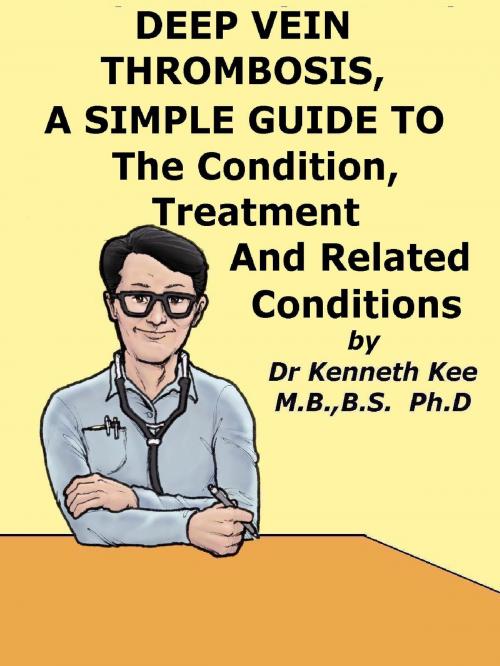Deep Vein Thrombosis, A Simple Guide To The Condition, Treatment And Related Conditions
Nonfiction, Health & Well Being, Medical, Specialties, Internal Medicine, Hematology| Author: | Kenneth Kee | ISBN: | 9781310212611 |
| Publisher: | Kenneth Kee | Publication: | September 20, 2015 |
| Imprint: | Smashwords Edition | Language: | English |
| Author: | Kenneth Kee |
| ISBN: | 9781310212611 |
| Publisher: | Kenneth Kee |
| Publication: | September 20, 2015 |
| Imprint: | Smashwords Edition |
| Language: | English |
Deep Vein Thrombosis
I had a patient who arrived from England 5 years ago to visit her relatives.
She had breathing difficulty and chest tightness when the plane reached the Singapore airport and was rushed to see the airport’s private clinic doctor.
However she had an ECG done and was treated as a case of mild asthma and given some medicine.
Because she did not improve and her leg started to hurt, her relative brought her to see me 2 days later.
On examination I could see a painful red warm swelling on the lower right leg together with some varicose veins.
Her lungs were congested with lower air entry on the right lung.
Her blood pressure was normal but her heart rate was 98 per minute.
I suspected deep vein thrombosis based on her history of an airplane travel stasis and the swollen painful right leg.
Based on her ECG at the airport clinic, I did not think that she had a heart attack
I immediately gave her an intravenous injection of heparin together with aminophylline (a bronchodilator).
She seems to improve immediately after the injection.
The breathing was better and there was less chest tightness.
As she was reluctant to go for a venogram or to hospital, I did not want to use warfarin.
Instead I gave buffered aspirin (as an anticoagulant) and gave her a pressure stocking to wear on her leg which should be kept raised while sitting and sleeping.
She was also given a muscle relaxant together with paracetamol (a painkiller) which should help to her to sleep better.
She was told to return for review the next day.
The next day when she returned she was feeling better.
The breathing was better and the heart rate was back to 76 per minute.
She also had a good night sleep and her leg was less swollen and not so inflamed.
By the end of the second week she was much better and returned to England where she was advised to see her GP who then referred her to a UK hospital where her DVT was confirmed.
What is deep vein thrombosis?
Deep vein thrombosis (DVT) is a blood clot (thrombus) in a deep vein leading to the heart, usually in the legs.
The blood clot may either block the vein completely or partially.
It is more common in the elderly and the obese.
Women are more prone to it.
DVT does not cause heart attack or stroke.
What is the danger of DVT?
Clots can form in superficial veins (called superficial thrombophlebitis or phlebitis) and in deep veins due to poor blood flow or stasis.
Blood clots in superficial veins rarely cause serious problems.
Blood clots in deep veins (deep vein thrombosis) require immediate medical care.
These clots are dangerous because they can break loose and then travel through the bloodstream to the lungs causing a pulmonary embolism.
A pulmonary embolism is often life-threatening.
Deaths resulting from complications of DVT are not something new.
Blood clots most often develop in the calf and thigh veins, and less often in the arm veins or pelvic veins.
What causes deep vein thrombosis?
3 major factors play a part in the development of DVT.
1. Venous stasis i.e. the pooling of blood in the veins.
This may be the result of immobility, old age or heart failure.
2. Damage of the vein due to trauma or local pressure.
Surgery or an injury can damage your blood vessels and cause a clot to form.
3. Increased coagulability (tendency of blood to clot) of the blood which is sometimes seen in:
a. Clotting disorders,
b. Pregnancy,
c. The use of oral contraceptives,
d. Dehydration or
e. Some cancers.
Sitting for long periods without exercising your leg muscles is a main factor.
Passengers in first or economy class seats in a plane have been known to develop DVT.
Deep Vein Thrombosis
I had a patient who arrived from England 5 years ago to visit her relatives.
She had breathing difficulty and chest tightness when the plane reached the Singapore airport and was rushed to see the airport’s private clinic doctor.
However she had an ECG done and was treated as a case of mild asthma and given some medicine.
Because she did not improve and her leg started to hurt, her relative brought her to see me 2 days later.
On examination I could see a painful red warm swelling on the lower right leg together with some varicose veins.
Her lungs were congested with lower air entry on the right lung.
Her blood pressure was normal but her heart rate was 98 per minute.
I suspected deep vein thrombosis based on her history of an airplane travel stasis and the swollen painful right leg.
Based on her ECG at the airport clinic, I did not think that she had a heart attack
I immediately gave her an intravenous injection of heparin together with aminophylline (a bronchodilator).
She seems to improve immediately after the injection.
The breathing was better and there was less chest tightness.
As she was reluctant to go for a venogram or to hospital, I did not want to use warfarin.
Instead I gave buffered aspirin (as an anticoagulant) and gave her a pressure stocking to wear on her leg which should be kept raised while sitting and sleeping.
She was also given a muscle relaxant together with paracetamol (a painkiller) which should help to her to sleep better.
She was told to return for review the next day.
The next day when she returned she was feeling better.
The breathing was better and the heart rate was back to 76 per minute.
She also had a good night sleep and her leg was less swollen and not so inflamed.
By the end of the second week she was much better and returned to England where she was advised to see her GP who then referred her to a UK hospital where her DVT was confirmed.
What is deep vein thrombosis?
Deep vein thrombosis (DVT) is a blood clot (thrombus) in a deep vein leading to the heart, usually in the legs.
The blood clot may either block the vein completely or partially.
It is more common in the elderly and the obese.
Women are more prone to it.
DVT does not cause heart attack or stroke.
What is the danger of DVT?
Clots can form in superficial veins (called superficial thrombophlebitis or phlebitis) and in deep veins due to poor blood flow or stasis.
Blood clots in superficial veins rarely cause serious problems.
Blood clots in deep veins (deep vein thrombosis) require immediate medical care.
These clots are dangerous because they can break loose and then travel through the bloodstream to the lungs causing a pulmonary embolism.
A pulmonary embolism is often life-threatening.
Deaths resulting from complications of DVT are not something new.
Blood clots most often develop in the calf and thigh veins, and less often in the arm veins or pelvic veins.
What causes deep vein thrombosis?
3 major factors play a part in the development of DVT.
1. Venous stasis i.e. the pooling of blood in the veins.
This may be the result of immobility, old age or heart failure.
2. Damage of the vein due to trauma or local pressure.
Surgery or an injury can damage your blood vessels and cause a clot to form.
3. Increased coagulability (tendency of blood to clot) of the blood which is sometimes seen in:
a. Clotting disorders,
b. Pregnancy,
c. The use of oral contraceptives,
d. Dehydration or
e. Some cancers.
Sitting for long periods without exercising your leg muscles is a main factor.
Passengers in first or economy class seats in a plane have been known to develop DVT.















